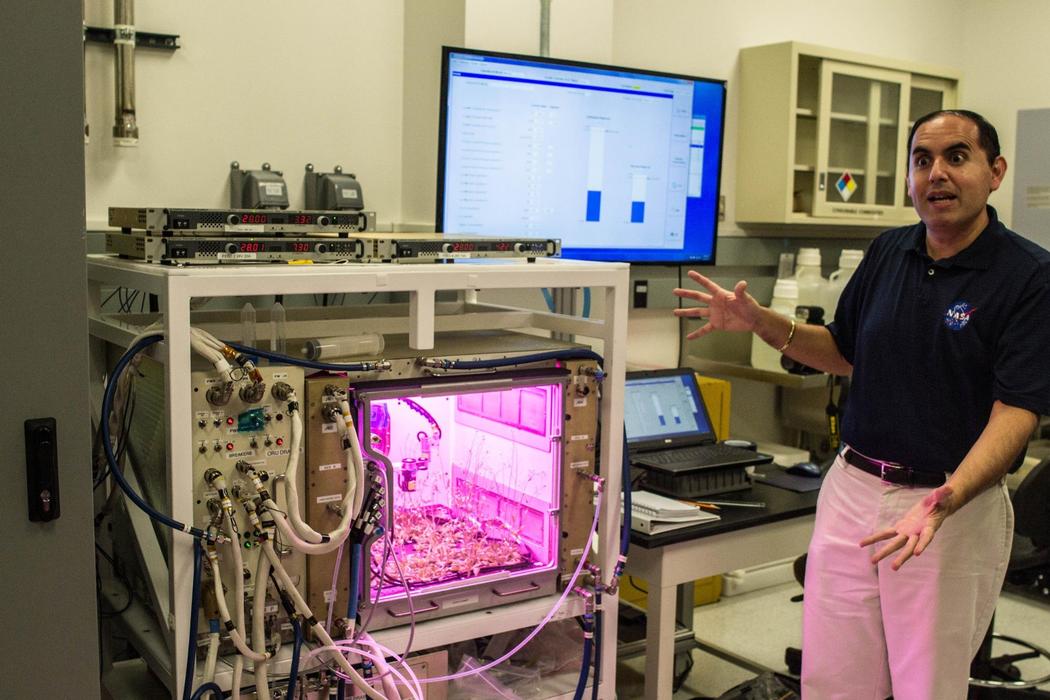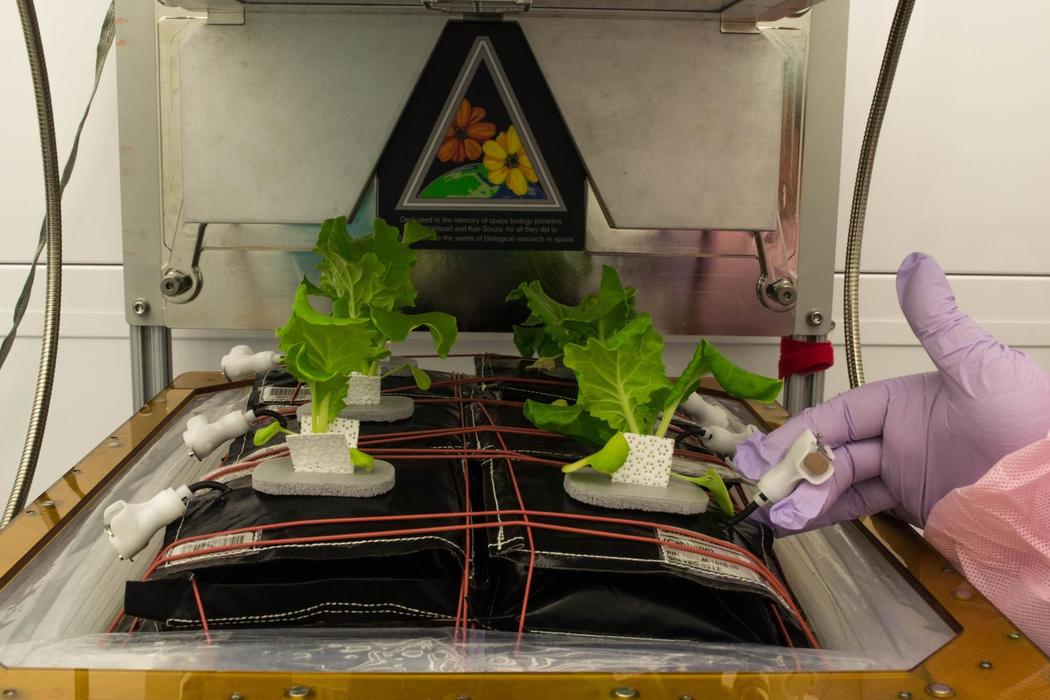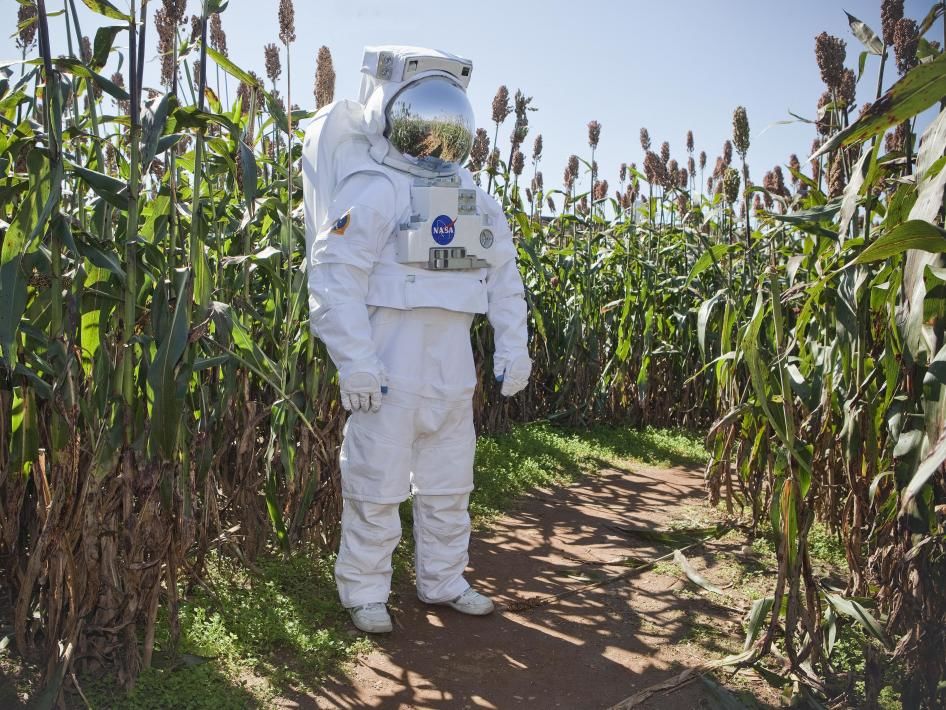Vegetables for astronauts: how to grow fresh greens in NASA laboratories

Astronaut Scott Kelly on the background of the Veggie system with lettuce grown on the ISS
In order to feel well, a person needs not so much: healthy sleep, exercise, good nutrition and a couple of things. Food here is one of the critical factors. And this factor becomes even more important when it comes to the well-being of a person in orbit. Going into orbit for several months, astronauts should receive high-quality food with a balanced content of useful substances, including vitamins. Well, the best way to get vitamins is to include fresh vegetables and fruits in your diet.
The situation with fruits is not very good (although from time to time they fall on the ISS), but astronauts now receive vegetables on a regular basis. In addition, NASA experts are developing a program of growing plants directly on the ISS (part of the program has already been implemented) or on board a spacecraft that, for example, flies to Mars. The journey to the Red Planet will take several months, and it will not be possible to deliver food from Earth to the ship, as it is done for astronauts aboard the ISS. Therefore, scientists have come to the conclusion that it is necessary to learn how to grow some of the products right on the ship.
The development of the farm in space program is being carried out by a team of researchers from the John Fitzgerald Kennedy Space Center (Florida, USA).
')
It is worth noting that the astronaut's diet should include fresh vegetables, started talking only in 2014-2015. Prior to this, people in orbit received only dehydrated dry freeze products that need to be prepared in a special way so that they can be eaten. The astronauts do not complain about the taste, but we must think that in addition to such food they want something else. By the way, the cost of food for space travelers is very high. Taking into account the delivery to orbit, the price is about $ 20,000 per kg. It is extremely expensive, but it does not work out otherwise. If you grow some of the products already in space, you can save a little.
The first experiments have already shown a good result: they have learned how to grow lettuce on board the ISS. His taste was quite acceptable. Growing plants in space has become possible thanks to a special system developed by NASA. This system is called Veggie . It was first delivered to the ISS in April 2014. And in August 2015, fresh greens grown in microgravity conditions were included in the astronaut menu.
And this is not the only system for growing plants on the ISS. For example, in the Russian segment of the International Space Station, the Lada space greenhouse, created by specialists from the Institute of Biomedical Problems of the Russian Academy of Sciences, operates.
In addition to Veggie and Lada, there are other developments. NASA is now actively developing the Advanced Plant Habitat (APH) project, which is creating another system for growing plants in microgravity. Externally, the system looks like a microwave enlarged several times. Inside it is a microclimate that experts can control. In particular, it is possible to change the content of oxygen, nutrients, replace one nutrient by another.
The new system has shown itself well: scientists have already managed to grow Arabidopsis, a species close to cabbage. A set of LEDs is used as lighting. A special computer manages everything, since it is quite difficult for a person to control all indicators, and if we are talking about the work of such a system in orbit, the astronauts simply do not have time to pay much attention to the space farm.
According to the developers , APH is the “big brother of Veggie”. The computer system, which was discussed above, can automatically adjust the microclimate for growing different types of plants. Soon Veggie will be replaced by this system, it is planned to deliver it during several subsequent flights to the ISS. One of the tasks of scientists who are engaged in the development of APH is to grow some plant species in orbit, get their seeds, deliver them to Earth, grow them again, get seeds, send seeds to the ISS. At the station from these seeds will receive plants that will be carefully studied. Thus, experts want to understand whether seeds and plants will withstand the transit between the ISS and the Earth with constantly changing gravity.

One of the leaders of the APH project talks about the principle of the system (it is also in the photo). Source: Daniel Oberhaus / Motherboard
In addition to APH, project participants are developing other systems where some conditions specific to the ISS are tested. The Kennedy Space Center has created several rooms in which, along with other parameters, it is possible to control the humidity or the level of carbon dioxide. Plants are also grown in these rooms to check how their growth and development take place under conditions different from those on the ground (only gravity remains on the ground). It also studies plants that were grown on the ISS, and then delivered to Earth. Last Friday, astronauts on the ISS gathered another crop . So far, these experiments are successful, the plants feel good. The astronauts themselves get the amount of vegetables they need to feed themselves - for now this is just lettuce and Chinese cabbage.

This is Beijing cabbage grown on Earth with the repetition of the conditions of the ISS.
An interesting point: in orbit, in microgravity, the sense of taste in a person is dulled. Therefore, to get more pleasure from food, astronauts need products with a higher content of spices, salt and other components than on Earth. This is one of the reasons why Peking cabbage is grown on the ISS. She has a sharper, pronounced taste than that of the same salad. Plus, it is growing rapidly, and the amount of nutrients in it is higher than in some other vegetables.
NASA is also studying the long-term aspects of growing plants in space. This is done by a separate group of specialists headed by Ralph Fritsche. According to him, Veggie is only the first experiment in a series of similar projects. APH is a research platform. Scientists must understand what will happen in space with plants that have a long series of “ancestors” who did not know any conditions other than space. Unfortunately, scientists cannot reproduce microgravity in their laboratories, but all the other parameters of the ISS microclimate can be reproduced without problems.
As for microgravity, it is very important to check the growth and development of plants in such conditions, since these conditions are significantly different from those of the earth. For example, in microgravity, water behaves not at all like on Earth. On the planet, moisture seeps into the ground, where it is absorbed by the roots of plants. But in space it is impossible to water the same salad in the usual way. The water will simply collect in a balloon and float through the air. There are problems with the delivery of oxygen to plant tissues. These issues are gradually being resolved, and NASA has already implemented a number of systems that help simulate these microgravity features on Earth.
Among other original solutions, NASA engineers proposed using a special nylon substrate created with a 3D printer. He plays the role of the soil. The substrate is shaped as a cube. Seeds are located in the upper part of the cube, and water penetrates into the pores and is retained in the substrate. Nylon is a hydrophilic compound, so that the water molecules, “sticking” to the nylon molecules, do not go outside, the moisture gets to where it is needed. The roots of the plants, penetrating into the cube, branch out and get moisture in the right amount for the plant. Scientists plan to test the behavior of their system in microgravity during the flights on specials. NASA aircraft. If the experiment is successful, the nylon farm will go to the ISS for further experiments. In this project, NASA engineers are assisted by scientists from the University of Utah.
The same system, according to Fritsche, is also suitable for growing plants on Mars. There it will be even easier to grow them than on the ISS, since there is gravity on the red planet. Water and gases behave there in the same way as on Earth.
Now the main task of specialists is to achieve the maximum increase in the mass of plants per unit of time, with minimal resources such as water and nutrients. In the future, we are confident in NASA, systems such as APH will be distributed at orbital stations and on other planets. Colonists of Mars, for example, with the help of APH type farms will be able to get the necessary vegetables to their table. The substrate for plants, according to Fritsche, can repeat the current development - and the 3D printers will be with the colonists.

True, there are other opinions. Since 2013, scientists from Holland have been conducting an experiment on growing plants on the ground, which, they believe, is similar in structure and composition to the soil of Mars. More than ten harvests of different plant species have been grown on this medium. As it turned out , the content of heavy metals in the tissues of grown plants is not dangerous for humans.
In general, the subject of space farms is becoming increasingly relevant, as people plan to fly not only to Mars, but also to the Moon. Here, too, there is soil, and if the same Chinese or Indians produce helium-3, then they will have to base long-term settlements on Earth's satellite. Residents of such settlements fresh vegetables to the table will also be needed.
Source: https://habr.com/ru/post/401875/
All Articles